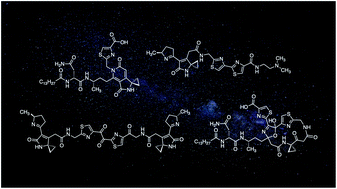Employing chemical synthesis to study the structure and function of colibactin, a “dark matter” metabolite
Abstract
Covering: 2015 to 2020
The field of natural products is dominated by a discovery paradigm that follows the sequence: isolation, structure elucidation, chemical synthesis, and then elucidation of mechanism of action and structure–activity relationships. Although this discovery paradigm has proven successful in the past, researchers have amassed enough evidence to conclude that the vast majority of nature's secondary metabolites – biosynthetic “dark matter” – cannot be identified and studied by this approach. Many biosynthetic gene clusters (BGCs) are expressed at low levels, or not at all, and in some instances a molecule's instability to fermentation or isolation prevents detection entirely. Here, we discuss an alternative approach to natural product identification that addresses these challenges by enlisting synthetic chemistry to prepare putative natural product fragments and structures as guided by biosynthetic insight. We demonstrate the utility of this approach through our structure elucidation of colibactin, an unisolable genotoxin produced by pathogenic bacteria in the human gut.

- This article is part of the themed collection: Synthetic strategies for mining the information-rich content of natural products


 Please wait while we load your content...
Please wait while we load your content...